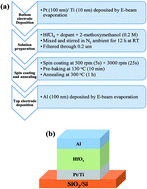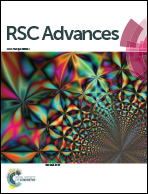Control of resistive switching behaviors of solution-processed HfOX-based resistive switching memory devices by n-type doping
Abstract
In this study, we investigated the effect of Ni and Ta doping on resistive switching behaviors of solution-processed HfOX-based resistive switching memory (RRAM) devices. The observations are discussed in terms of oxygen vacancies according to doping concentration. The initial resistance and forming voltages are influenced by doping concentration due to the reduction of formation energy of oxygen vacancies, whereby a higher concentration of dopant results in a lower forming voltage and initial resistance of RRAM devices. In addition, the Ni dopant has a significant effect on forming processes in HfOX-based RRAM devices. It is observed that 10% of Ni doping can lead to forming-free behaviors. This study demonstrates the facile control of resistive switching behaviors by doping processes during the preparation of solutions and suggests that proper doping is an easy method that can lead to modulation of RRAM properties for future nonvolatile memory applications.


 Please wait while we load your content...
Please wait while we load your content...